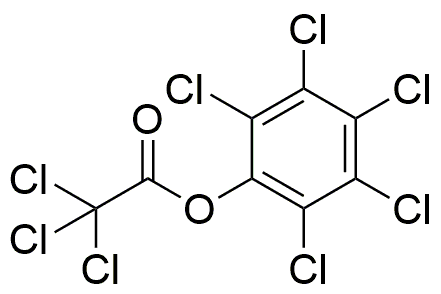Pentachlorophenyl trichloroacetate is widely utilized in research focused on:
- Pesticide Development: This compound serves as a key intermediate in the synthesis of various pesticides, enhancing agricultural productivity by effectively controlling pests.
- Environmental Studies: It is used in studies examining the degradation of chlorinated compounds in soil and water, helping researchers understand environmental impacts and remediation strategies.
- Analytical Chemistry: The compound is employed as a standard in analytical methods to detect and quantify chlorinated organic pollutants, ensuring accurate environmental monitoring.
- Pharmaceutical Research: It acts as a building block in the synthesis of certain pharmaceuticals, contributing to the development of new therapeutic agents.
- Material Science: The compound is explored for its potential applications in creating flame retardant materials, providing safety benefits in various industries.
General Information
Properties
Safety and Regulations
Applications
Pentachlorophenyl trichloroacetate is widely utilized in research focused on:
- Pesticide Development: This compound serves as a key intermediate in the synthesis of various pesticides, enhancing agricultural productivity by effectively controlling pests.
- Environmental Studies: It is used in studies examining the degradation of chlorinated compounds in soil and water, helping researchers understand environmental impacts and remediation strategies.
- Analytical Chemistry: The compound is employed as a standard in analytical methods to detect and quantify chlorinated organic pollutants, ensuring accurate environmental monitoring.
- Pharmaceutical Research: It acts as a building block in the synthesis of certain pharmaceuticals, contributing to the development of new therapeutic agents.
- Material Science: The compound is explored for its potential applications in creating flame retardant materials, providing safety benefits in various industries.
Documents
Safety Data Sheets (SDS)
The SDS provides comprehensive safety information on handling, storage, and disposal of the product.
Product Specification (PS)
The PS provides a comprehensive breakdown of the product’s properties, including chemical composition, physical state, purity, and storage requirements. It also details acceptable quality ranges and the product's intended applications.
Certificates of Analysis (COA)
Search for Certificates of Analysis (COA) by entering the products Lot Number. Lot and Batch Numbers can be found on a product’s label following the words ‘Lot’ or ‘Batch’.
Numéro de catalogue
Numéro de lot/série
Certificates Of Origin (COO)
This COO confirms the country where the product was manufactured, and also details the materials and components used in it and whether it is derived from natural, synthetic, or other specific sources. This certificate may be required for customs, trade, and regulatory compliance.
Numéro de catalogue
Numéro de lot/série
Safety Data Sheets (SDS)
The SDS provides comprehensive safety information on handling, storage, and disposal of the product.
DownloadProduct Specification (PS)
The PS provides a comprehensive breakdown of the product’s properties, including chemical composition, physical state, purity, and storage requirements. It also details acceptable quality ranges and the product's intended applications.
DownloadCertificates of Analysis (COA)
Search for Certificates of Analysis (COA) by entering the products Lot Number. Lot and Batch Numbers can be found on a product’s label following the words ‘Lot’ or ‘Batch’.
Numéro de catalogue
Numéro de lot/série
Certificates Of Origin (COO)
This COO confirms the country where the product was manufactured, and also details the materials and components used in it and whether it is derived from natural, synthetic, or other specific sources. This certificate may be required for customs, trade, and regulatory compliance.


